List of Authors
>>About this blog
Recent blog post
|
[Nojinya]
August 22, 2015 09:00
Ginza is lined with high-end brand shops, with the appearance of foreign tourists. In particular, while walking along Marronnier Street and Chuo-dori starting from Plantan Ginza, looking at the gorgeous show windows such as Cartier and Chanel, I feel like I'm walking somewhere in Europe.
By the way, because it is such a Ginza, there are many restaurants where you can enjoy the deliciousness of all over the world regardless of whether you want to go for lunch, but today is a late lunch, so I would like to assault a super popular store in Ginza that people who know a little. The location is in "Ginza Ins 3" under Tokyo Kosoku Doro, which I previously introduced in my blog post "Tokyo Kosoku Doro-Contemporary Great Wall Surrounding Ginza" (/archive/2015/08/post-2643.html). of all over the world regardless of whether you want to go for lunch, but today is a late lunch, so I would like to assault a super popular store in Ginza that people who know a little. The location is in "Ginza Ins 3" under Tokyo Kosoku Doro, which I previously introduced in my blog post "Tokyo Kosoku Doro-Contemporary Great Wall Surrounding Ginza" (/archive/2015/08/post-2643.html). 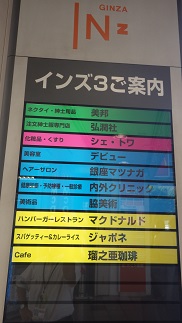 The name of the shop is "Japone". 。 。 The name of the shop is "Japone". 。 。
I walk to the back side of a tailor, barber shop, etc. with the scent of Showa somehow. Then suddenly there was a bare counter in the hallway. 。 。 It was a shame for those who imagined French cuisine from their name! This is a B-grade gourmet, baked spaghetti shop known as "Lome Spa" for some enthusiastic fans. Today, lunch was quite late, so I didn't have to line up in the line, but it's a very popular shop with about 20 people along the clinic and Mac wall during lunchtime. 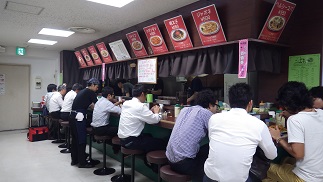 According to the store's mouth, "Japone (Japan) boasts flavors that match the taste of Japanese people as the store name suggests. In addition, with the motto of customer-oriented and service first, we are looking forward to your visit with a variety of menus such as Japanese, Chinese, Western style and curry rice with a wide variety of menus." In addition to Spaghetti classic Napolitan, Indian (curry taste), Japone (Japanese style soy sauce flavor), Chinese soy sauce flavor, Chinese soy sauce flavor, Chinese flavor, Chinese flavor, Chinese flavor, Chinese flavor, Chinese flavor, Chinese flavor, Chinese flavor, Chinese flavor, Chinese flavor, Chinese flavor, Chinese flavor, Chinese flavor, Chinese flavor, Chinese flavor, Chinese flavor, Chinese flavor, Chinese flavor, Chinese flavor, Chinese flavor, Chinese flavor, Chinese flavor, Chinese flavor, Chinese flavor, Chinese flavor, Chinese flavor, Chinese flavor, Chinese flavor, Chinese flavor, Chinese flavor, Chinese flavor, Chinese flavor, Chinese flavor, Chinese flavor, Chinese flavor, Chinese flavor, Chinese flavor, Chinese flavor, Chinese flavor, Chinese flavor, There are three sizes: regular (Namimori), jumbo (Omori), and Yokozuna (Ultra Omori). Even considering the location of Ginza, the price is quite cheap, regular 500-600 yen, and Yokozuna 750-800 yen, so long lines are always formed during normal lunchtime. According to the store's mouth, "Japone (Japan) boasts flavors that match the taste of Japanese people as the store name suggests. In addition, with the motto of customer-oriented and service first, we are looking forward to your visit with a variety of menus such as Japanese, Chinese, Western style and curry rice with a wide variety of menus." In addition to Spaghetti classic Napolitan, Indian (curry taste), Japone (Japanese style soy sauce flavor), Chinese soy sauce flavor, Chinese soy sauce flavor, Chinese flavor, Chinese flavor, Chinese flavor, Chinese flavor, Chinese flavor, Chinese flavor, Chinese flavor, Chinese flavor, Chinese flavor, Chinese flavor, Chinese flavor, Chinese flavor, Chinese flavor, Chinese flavor, Chinese flavor, Chinese flavor, Chinese flavor, Chinese flavor, Chinese flavor, Chinese flavor, Chinese flavor, Chinese flavor, Chinese flavor, Chinese flavor, Chinese flavor, Chinese flavor, Chinese flavor, Chinese flavor, Chinese flavor, Chinese flavor, Chinese flavor, Chinese flavor, Chinese flavor, Chinese flavor, Chinese flavor, Chinese flavor, Chinese flavor, Chinese flavor, Chinese flavor, There are three sizes: regular (Namimori), jumbo (Omori), and Yokozuna (Ultra Omori). Even considering the location of Ginza, the price is quite cheap, regular 500-600 yen, and Yokozuna 750-800 yen, so long lines are always formed during normal lunchtime.
When I was a student, I was a "Girorian (* Note: Ramen Jiro fan)", but I ordered Stan Dart Japone without the courage like when I was young. After waiting for about 15 minutes, the classic "Japone Regular" finally came out. 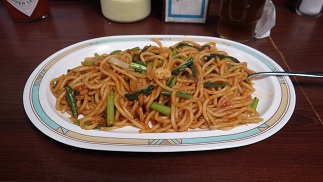 Spaghetti is completely different from fashionable Italian pasta, similar to yakisoba with thick noodles, onions, komatsuna, and pork snuggle up, and soy sauce flavor. Although the volume was abundant, it was Spaghetti is completely different from fashionable Italian pasta, similar to yakisoba with thick noodles, onions, komatsuna, and pork snuggle up, and soy sauce flavor. Although the volume was abundant, it was delicious with "seasoning according to the taste of Japanese people" as the shop's mouth. As expected, Omori and Yokozuna will not be possible in the future, but next time I returned to work in the afternoon, thinking that I would like to try the popular menu Jariko. delicious with "seasoning according to the taste of Japanese people" as the shop's mouth. As expected, Omori and Yokozuna will not be possible in the future, but next time I returned to work in the afternoon, thinking that I would like to try the popular menu Jariko.
[Japone]
〒104-0061 Ginza-Nishi 1-chome, Chuo-ku Ginza-Nishi 1-chome, Ginza Ins 3 1F
(Now Exit 1 of Ginza 1-chome Station on the Yurakucho Line)
TEL: 03-3567-4749
Business hours 1030-2000 (Saturday holidays until 1600 until Saturday)
[Nojinya]
August 19, 2015 14:00
On the evening of the weekend, after the business in Hamacho is over, walk around the Sumida River Terrace in the direction of Eitai Bridge. The sun has fallen completely, and the light blue lit up of Eitai Bridge is vivid on the surface of the water. The heat of the daytime subsides somewhat, and the lighting of the houseboat, which travels with the wind across the river surface, is refreshing.
There is the Nihonbashi River in front of Eitai Bridge, so the Sumida River Terrace is once interrupted and goes up the stairs. Then there was a crowd around Toyomi Bridge. 。 。
"I'll ask you quietly!" 。 In front of the bridge, the monitor TV and the staff who stare at it. And from the top of the bridge, you can hear the narrative of a woman like you thought.
Yes, it was the shooting site of the drama. Not only this time, but in Chuo-ku, I often go to drama location sites. Originally set in Chuo-ku, a drama based on Keigo Higashino's mystery novel, "Newcomer" (Ningyocho), and "Himi" (Tsukushima / Tsukuda:) introduced in a previous blog post.
/archive/2014/12/wonhk.html) In Chuo-ku, of course, will be performed in Chuo-ku in addition to the location of drama on the stage, but locations will be performed in Chuo-ku, including those whose stage is not explicitly Chuo-ku. There seems to be quite a few cases. Many dramas are originally set in Tokyo, so it is natural to shoot dramas in Tokyo, but it is natural that there are many drama shootings in Tokyo, but it is blessed with history and waterside, and Ryuishi has many landscapes that become picturesque, from love things to serious works Many drama locations are performed in the city, up to them.
"Full open girl" was broadcast on Fuji TV's "Month 9" frame in 2011. At that time, I accidentally encountered the location (Episode 9: the appearance of Riki Takeuchi and Yui Aragaki) that was being held at Chuo Daizu. Wakaba Ayukawa, who aims to be an international lawyer played by Yui Aragaki, will work as a barbari and a new lawyer at a law firm, and will take care of the daughter of the office director, Hinata, through the Mitsuba Forest Nursery School where Hyuga passes. A story that he has various relationships with the people of downtown. This drama is a drama that "the stage is not explicitly Chuo-ku" in the previous classification, but Hamarikyu, Chuo-ohashi Bridge, Toyomi Bridge, Eitai Bridge, Tsukishima Nishinaka Dori, Tsukuda Kobashi, Yamagata Bank Tokyo Branch (Kyobashi), TCAT (TCAT). 。 。 According to a friend of drama-dori, the appearance scene in Chuo-ku is 44 times in total (11 episodes in total), and somewhere in Chuo-ku appears almost every time.  [Released from the DVD Pony Canyon] [Released from the DVD Pony Canyon]
Since the location schedule is not announced, it may be difficult to visit the location site, but it seems that you can easily enjoy Chuo-ku, which appears in dramas and movies. On a day when you want to refrain from going out in summer batter, it is a good idea to enjoy a walk in Chuo-ku on DVD.
[Nojinya]
August 18, 2015 09:00
August is a season when there are many festivals nationwide, but there are many events in Chuo-ku, including Sumiyoshi Taisha Shrine Reitaisai festival, Tokyo Bay Fireworks Festival, and Tomioka Hachimanji Miya carrying of miniature shrines. I would like to see a blog post from my correspondent, and last Sunday, August 9th was National Day in Singapore. This year was  a memorable year of 50 years of independence from the Federal Republic of Malay, and it seems to be a fairly grand festival. In recent years, when the midsummer climate continues in Chuo-ku, I visited a Singapore restaurant in Hatchobori today to enjoy the ever-summer Singapore mood. a memorable year of 50 years of independence from the Federal Republic of Malay, and it seems to be a fairly grand festival. In recent years, when the midsummer climate continues in Chuo-ku, I visited a Singapore restaurant in Hatchobori today to enjoy the ever-summer Singapore mood.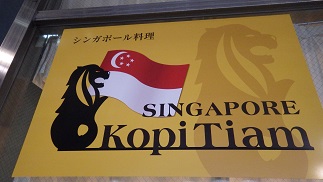
The name of the shop is "Kopi Tiam", which is often heard in Singapore. It means a "coffee shop" with Tiam (store; Fujian) attached to the Malay word Kopi (coffee), and it is an image of a coffee shop or snack shop that offers snacks in addition to drinks such as coffee.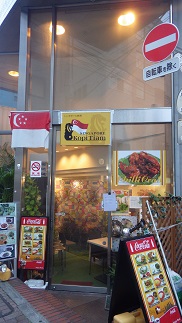
When you open the automatic door of the shop along Suzuran Street and enter, there is a space where about 20 people can sit under the fluorescent light. 。 。 It's already full of Southeast Asian mood. There are black and white photographs of old Singapore on the wall, which further enhances the atmosphere.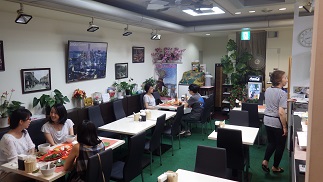
We arrive at a white table that we don't care about, and first we will have a classic "Tiger Beer ". I'd like to drink on the jokki and on the rocks like the Hawker Center (outdoor food court) in Singapore, but today I'm polite to have a glass straight. ". I'd like to drink on the jokki and on the rocks like the Hawker Center (outdoor food court) in Singapore, but today I'm polite to have a glass straight.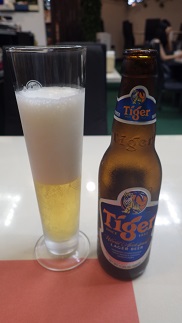
The restaurant recommends the typical Singapore cuisine "Hainan Chicken Rice", "Nashigoren (Indonesia-style stir-fried rice)," meat bone tea (bakute), "South India-style curry" and the Hawker Center in Singapore. That should be the case, and his husband, Mrs. and Mrs. A, lived in Singapore 30 years ago, so they seem to know the local taste. Even after returning to Japan, the shop was opened in Tokyo as a place where you can enjoy authentic Singapore cuisine, and the taste of Singaporeans living in Tokyo also goes to the shop with origami.
I decided to have "meat bone tea" tonight. If you're not familiar with Singaporean cuisine, hear it's meat bone tea. ? ? I think so please give me a mini commentary here. 。 。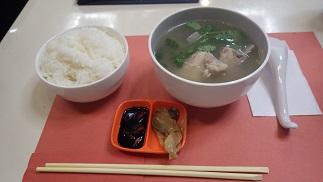
It contains the word "tea", but as you can see, it is a medicinal soup that contains pork with bone, not tea. It seems to originate from the cuisine of Fujian, the hometown of bitterness (Kouri; migrant workers from China) during the colonial period of British territory. There is only a dish developed as a meal for port workers on the Malay Peninsula, which has a severe climate, and plenty of meat contains garlic, cinnamon, pepper, pacchi and other spices, and it is full of nutrients and energy. I'm going to survive this heat. Next time, by all means, I would like to try "South India-style curry" recommended on the way home. My husband says it's quite painful, but I'm looking forward to it now.
【Singapore Kopi TIam】
〒104-0032 2-18-5, Hacchobori, Chuo-ku, Tokyo
TEL: 03-6280-3442
Business hours 1800-2200 (Lunch is also open and closed on weekends and holidays)
[Nojinya]
August 16, 2015 14:00
Do you know the road called Tokyo Kosoku Doro? It is an expressway that runs around Ginza from Shinkyobashi to Horai Bridge (Shimbashi). This road, which looks like a wall that protects the city of Ginza, if you have walked around Ginza, you may have always seen it. Appeared several times in my blog post ("Slightly Drinking at a liquor store in Ginza-Ginza Kimishimaya Shell" and others:
/archive/2015/08/post-2627.html), so I would like to take up this expressway this time.
Speaking of expressways, I think of national roads such as the Tomei Expressway, and the Metropolitan Expressway in Tokyo, but this 2 km long road that runs around Ginza was established in 1951 mainly by private companies (road opening was in 1959). It is an expressway that was done.
It is a road that also serves as a bypass for the Metropolitan Expressway Toshin Beltway by connecting with the Metropolitan Expressway Yaesu Line (Y) and Toshin Beltway (C1), so if you are a driver, you may have passed once before noticing. I think there is.
[Tokyo Kosoku Doro Map (Source: Tokyo Kosoku Doro Co., Ltd. HP)]
In addition, it is unique that the toll is free, even though it is on this road and highway.
Of course, in the case of getting in from the Metropolitan Expressway, for example, if you enter from Tsuchihashi Entrance (Ginza 8-chome) in front of Shimbashi Station and get off at Shinkyobashi (Ginza 1-chome), you will have to pay for it, and it seems that it was free because it was originally madeouter moat, Kyobashi and Shiodome rivers. On the other hand, there is a question about how to do construction costs and maintenance of expressways free of charge, but the secret is the use of space under expressways.
[Tokyo Kosoku Doro Conceptual Diagram (Source: Tokyo Kosoku Doro Co., Ltd. HP)]
While the third floor is used as an expressway, the lower space is a commercial space with about 400 stores. Ginza Ins, Nishiginza Department, Ginza Five, Corridor Street, Ginza Nine, etc. It is used as a space for taxi companies, parking lots, etc., as well as a familiar restaurant area such as Ginza Ins, Nishiginza Department, Ginza Five, Corridor Street, Ginza Nine, etc. We introduced the previous blog post "Public-Private Partnership (PPPP Partnership (PPPP) Partnership (PPPPPPPPPPPPP)", which uses the Roof-P), which covers the Roof-P), which covers the Roof" (P), which covers the public-P), which covers the cost of the cost of Edo Bus", which uses the cost of the cost of the cost of the public-PPPP), which uses the cost of the cost of the rental income obtained from the cost of the rental income obtained from the public-P), which uses the rental income from: /archive/2015/08/post-2618.html) is used to create a groundbreaking mechanism that preempts forward.
By the way, it is a shop under Tokyo Kosoku Doro, but there are attractive shops such as Ginza Kimishimaya, a standing drinker introduced at the beginning. From the next time, I would like to introduce it one by one in "Chorror Visiting Shopping Streets". I'm looking forward to it!
[Nojinya]
August 13, 2015 09:00
I think there are many people who go abroad during summer vacation. This year's first World Exposition is being held in Milan for the first time in five years. The theme of the exposition is "Food for the Earth and Energy for Life (Nutrire il pianeta, energia per la vita)". 。 。 It's just "food." At the pavilion in each country, the Japanese Pavilion showcases its own ingredients and cuisine, and at the Expo, the Japanese Pavilion has been promoting "Wahoku" by UNESCO Intangible Cultural Property to the world. during summer vacation. This year's first World Exposition is being held in Milan for the first time in five years. The theme of the exposition is "Food for the Earth and Energy for Life (Nutrire il pianeta, energia per la vita)". 。 。 It's just "food." At the pavilion in each country, the Japanese Pavilion showcases its own ingredients and cuisine, and at the Expo, the Japanese Pavilion has been promoting "Wahoku" by UNESCO Intangible Cultural Property to the world.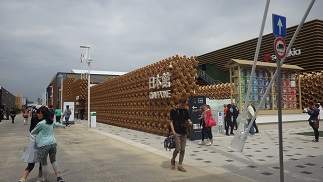 
Appearance of the Japan Pavilion at the Milan Expo, and the logo of EXPO Milano 2015.
The theme of "food" is Italy and the place is also Italy, so it is a Expo where you can fully enjoy eating and drinking delicious pasta and professional shoots (prospered ham) and Tuscanna wine with it. That's why I would like to explore Italian cuisine in Chuo-ku this time after the Milan Expo, which is being held in Italy.
By the way, in fact, Chuo-ku is a fierce battlefield of Italian cuisine known to those who know it. Just a short walk around the neighborhood of the house, there are three shops with the green, white and red Torico Lorre flags (according to Yahoo Loco Search, there are 771 Italian restaurants throughout Chuo-ku).
Anyway, I went to the nearby Italian dining room "Bettola il Bacca" and "Berry (berry) dining room". 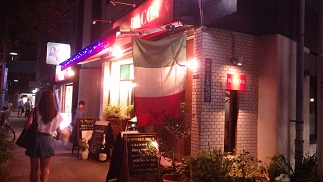 Master Kimishima says he tries to serve Italian local dishes that are not particular about specific local dishes. The table seats and the counter are in good balance. The atmosphere is easy to enter even if you want to drink alone or before meals. Master Kimishima says he tries to serve Italian local dishes that are not particular about specific local dishes. The table seats and the counter are in good balance. The atmosphere is easy to enter even if you want to drink alone or before meals.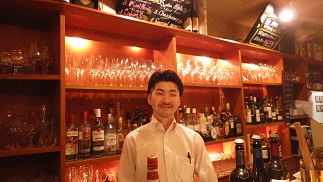
In addition to drinks, Italian wine that goes well with dishes is available, and there are plenty that goes well with dishes is available, and there are plenty  of beer. It mainly comes from domestic, Belgium, and England, but when I found my favorite Czech beer "Pilsner Urkel", of beer. It mainly comes from domestic, Belgium, and England, but when I found my favorite Czech beer "Pilsner Urkel",  it was a guts pose. it was a guts pose. 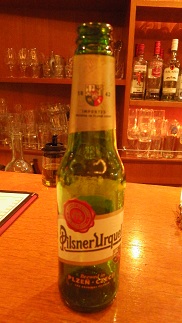 The beautiful knobs came out one after another along with the beer, and the "White Asparagus Milan-style truffle oil flavor" was also beautiful and delicious. The beautiful knobs came out one after another along with the beer, and the "White Asparagus Milan-style truffle oil flavor" was also beautiful and delicious.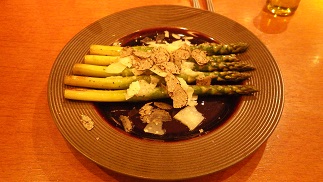
At the last end, Kimishima-san's recommendation was "Uni Tomato Cream Sauce Spaghetti". When he was full of stomach, he was drunk comfortably tonight and went home with a happy feeling. 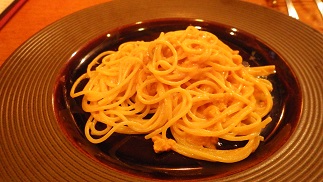 [Bettola il Bacca (Betla Il Bacca)] [Bettola il Bacca (Betla Il Bacca)]
〒104-0033 2-18-9 Shinkawa, Chuo-ku Nakagusuku Building 1F
(About a 5-minute walk from Hatchobori on the Keiyo Line and Hibiya Line. Near Tokyo Bus East 15/16 Shinkawa 2-chome bus stop)
TEL: 03-3553-8819
Business hours 1700-2400 (There is also lunch on weekdays and Saturday)
[Nojinya]
August 12, 2015 14:00
Last time, we introduced an antenna shop in Chuo-ku as "Heisei no Kurayashiki in Chuo-ku-Part 1-" (/archive/2015/08/-in-3.html).
After the unification of the world by Nobunaga and Hideyoshi, rice and product transactions began to be active throughout the country. It started with the construction of an office and warehouse (= Kurayashiki) as part of the clan residence in Edo, where the shogunate is located.
This time, we will take up regional banks ("local banks"), which are regional financial institutions that represent the region, as Heisei's Kurayashiki-Part 2. The Tokyo branch of the regional bank supports the expansion of local companies in Tokyo, and it can be said that it is a modern version of warehouse that is often found in Chuo-ku, the center of Tokyo.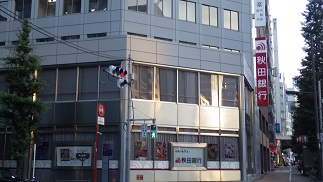
[Akita Bank (Kyobashi / Kajihata-dori)]
By the way, the number of regional banks throughout Japan (the first regional bank that is a member of the National Regional Bank Association) is 64, but although the exact number is unknown, nearly 90% of them are probably Nihonbashi, Kyobashi and Yaesu. It seems that they have a Tokyo branch in Chuo-ku. This is, of course, closely related to the Bank of Japan. 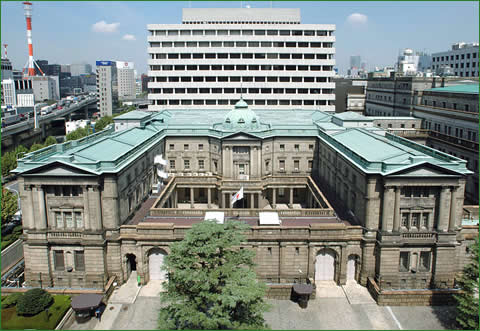 Bank of Japan (Honishi-cho) Bank of Japan (Honishi-cho)
Just as the daimyo set up a clan residence as a contact point with the Shogunate along with the purpose of residence of the family in Edo, the regional banks also set up services to business partners in Tokyo and receive supervision (examination) from the Bank of Japan. It seems that it was placed in Chuo-ku, the knee of the Bank of Japan.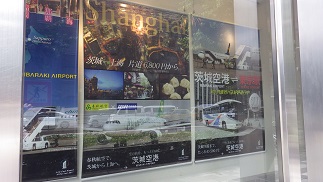
[Joyo Bank Show Window (Yaesu / Kajibashi Crossing])
Since it is the Tokyo branch of such a solid regional bank, there are many show windows that are relatively plain, such as introducing local specialties and famous places, but overturning such images at Hatchobori 2-chome intersection where Yaesu Street and Heisei Street intersect. Tokyo branch of a certain regional bank.
"OKB3 birth " 。 。 There is a flashy poster of a beautiful sister three, and I'm a little surprised! It's " 。 。 There is a flashy poster of a beautiful sister three, and I'm a little surprised! It's  a launch like a Ginza club rather than a local bank a launch like a Ginza club rather than a local bank  with a solid image. with a solid image.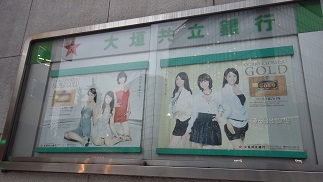
AKB's non-OKB is an acronym for Ogaki (Ogaki) Kyoritsu (Kyoritsu) Bank (Bank), an idol unit certified by Yasushi Akimoto, which was formed by recruiting members from female employees on their own. . In addition, OKB45 (45 people) has been added to OKB3, and it seems to be OKB48 in total. This is a remarkable bank PR, and OKB45 is also attracting events such as shopping streets around Gifu Prefecture. It seems that Ogaki Kyoritsu Bank is famous as an attacking bank in the industry, but according to a friend living in Gifu, Ogaki is a general store called "OKB Ranch" that is not an OK ranch (the naming is soft, but the Ogaki Kyoritsu Bank established It seems to be a regional bank with a fairly innovative culture. Thanks to such efforts, this bank ranked fourth in the Nikkei Financial Institution Ranking Survey (January 2015), which competes with high customer satisfaction, pushing megabanks and foreign banks.
[Toho Bank (Kyobashi / Chuo-dori)]
Enjoyment unique to Chuo-ku, where regional banks accumulate. Since it is a bank, you can't easily enter the store like an antenna shop, but if you find a colorful signboard in the city, why not look at the show window a little? There may be a new discovery.
|
Links
|
![]() of all over the world regardless of whether you want to go for lunch, but today is a late lunch, so I would like to assault a super popular store in Ginza that people who know a little. The location is in "Ginza Ins 3" under Tokyo Kosoku Doro, which I previously introduced in my blog post "Tokyo Kosoku Doro-Contemporary Great Wall Surrounding Ginza" (/archive/2015/08/post-2643.html).
of all over the world regardless of whether you want to go for lunch, but today is a late lunch, so I would like to assault a super popular store in Ginza that people who know a little. The location is in "Ginza Ins 3" under Tokyo Kosoku Doro, which I previously introduced in my blog post "Tokyo Kosoku Doro-Contemporary Great Wall Surrounding Ginza" (/archive/2015/08/post-2643.html).  The name of the shop is "Japone". 。 。
The name of the shop is "Japone". 。 。
 According to the store's mouth, "Japone (Japan) boasts flavors that match the taste of Japanese people as the store name suggests. In addition, with the motto of customer-oriented and service first, we are looking forward to your visit with a variety of menus such as Japanese, Chinese, Western style and curry rice with a wide variety of menus." In addition to Spaghetti classic Napolitan, Indian (curry taste), Japone (Japanese style soy sauce flavor), Chinese soy sauce flavor, Chinese soy sauce flavor, Chinese flavor, Chinese flavor, Chinese flavor, Chinese flavor, Chinese flavor, Chinese flavor, Chinese flavor, Chinese flavor, Chinese flavor, Chinese flavor, Chinese flavor, Chinese flavor, Chinese flavor, Chinese flavor, Chinese flavor, Chinese flavor, Chinese flavor, Chinese flavor, Chinese flavor, Chinese flavor, Chinese flavor, Chinese flavor, Chinese flavor, Chinese flavor, Chinese flavor, Chinese flavor, Chinese flavor, Chinese flavor, Chinese flavor, Chinese flavor, Chinese flavor, Chinese flavor, Chinese flavor, Chinese flavor, Chinese flavor, Chinese flavor, Chinese flavor, Chinese flavor, Chinese flavor, There are three sizes: regular (Namimori), jumbo (Omori), and Yokozuna (Ultra Omori). Even considering the location of Ginza, the price is quite cheap, regular 500-600 yen, and Yokozuna 750-800 yen, so long lines are always formed during normal lunchtime.
According to the store's mouth, "Japone (Japan) boasts flavors that match the taste of Japanese people as the store name suggests. In addition, with the motto of customer-oriented and service first, we are looking forward to your visit with a variety of menus such as Japanese, Chinese, Western style and curry rice with a wide variety of menus." In addition to Spaghetti classic Napolitan, Indian (curry taste), Japone (Japanese style soy sauce flavor), Chinese soy sauce flavor, Chinese soy sauce flavor, Chinese flavor, Chinese flavor, Chinese flavor, Chinese flavor, Chinese flavor, Chinese flavor, Chinese flavor, Chinese flavor, Chinese flavor, Chinese flavor, Chinese flavor, Chinese flavor, Chinese flavor, Chinese flavor, Chinese flavor, Chinese flavor, Chinese flavor, Chinese flavor, Chinese flavor, Chinese flavor, Chinese flavor, Chinese flavor, Chinese flavor, Chinese flavor, Chinese flavor, Chinese flavor, Chinese flavor, Chinese flavor, Chinese flavor, Chinese flavor, Chinese flavor, Chinese flavor, Chinese flavor, Chinese flavor, Chinese flavor, Chinese flavor, Chinese flavor, Chinese flavor, Chinese flavor, There are three sizes: regular (Namimori), jumbo (Omori), and Yokozuna (Ultra Omori). Even considering the location of Ginza, the price is quite cheap, regular 500-600 yen, and Yokozuna 750-800 yen, so long lines are always formed during normal lunchtime. Spaghetti is completely different from fashionable Italian pasta, similar to yakisoba with thick noodles, onions, komatsuna, and pork snuggle up, and soy sauce flavor. Although the volume was abundant, it was
Spaghetti is completely different from fashionable Italian pasta, similar to yakisoba with thick noodles, onions, komatsuna, and pork snuggle up, and soy sauce flavor. Although the volume was abundant, it was![]() delicious with "seasoning according to the taste of Japanese people" as the shop's mouth. As expected, Omori and Yokozuna will not be possible in the future, but next time I returned to work in the afternoon, thinking that I would like to try the popular menu Jariko.
delicious with "seasoning according to the taste of Japanese people" as the shop's mouth. As expected, Omori and Yokozuna will not be possible in the future, but next time I returned to work in the afternoon, thinking that I would like to try the popular menu Jariko.











 Master Kimishima says he tries to serve Italian local dishes that are not particular about specific local dishes. The table seats and the counter are in good balance. The atmosphere is easy to enter even if you want to drink alone or before meals.
Master Kimishima says he tries to serve Italian local dishes that are not particular about specific local dishes. The table seats and the counter are in good balance. The atmosphere is easy to enter even if you want to drink alone or before meals.
 The beautiful knobs came out one after another along with the beer, and the "White Asparagus Milan-style truffle oil flavor" was also beautiful and delicious.
The beautiful knobs came out one after another along with the beer, and the "White Asparagus Milan-style truffle oil flavor" was also beautiful and delicious.
 [
[
 Bank of Japan (Honishi-cho)
Bank of Japan (Honishi-cho)



